Page 18 of 25
Re: PhilBWright
Posted: Sun Apr 12, 2020 9:23 am
by PhilBJohnson
Easter morning Walk for a sense of well-being during "lockdown" (a time of pandemic).
8:30am
Who had seen a butterfly “on the wing”, before 8:00am in April?
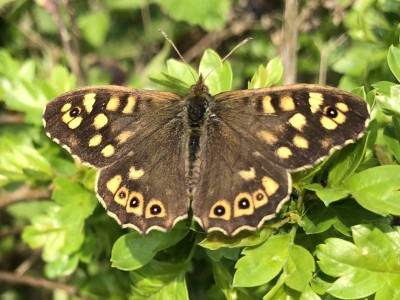
- A male Speckled Wood Butterfly. April 12th 8:30am
Re: PhilBWright
Posted: Sun Apr 12, 2020 4:57 pm
by David M
PhilBJohnson wrote: ↑Sun Apr 12, 2020 9:23 am
Easter morning Walk.
8:30am
Who had seen a butterfly “on the wing”, before 8:00am in April’a climate, warmer?
It
is somewhat unusual.
The earliest I've ever seen an active butterfly in the UK, Phil, is a Chequered Skipper at Glasdrum Wood, Argyll at 7.10am.
Notable though that night-time temperatures were in double figures and the sun is rising at 6 o'clock. Also, the Speckled Wood seems to have a higher tolerance for low temperatures than most other species.
Re: PhilBWright
Posted: Mon Apr 13, 2020 12:45 pm
by PhilBJohnson
Small White Pupa diary updates:
Monday 13th April 8°C, more pupa found in an early “Spring pupated, lighter colour formation”
Larva apparently overwintered in aubretia and pupated when seasonal temperatures allowed their life cycle to speed up:
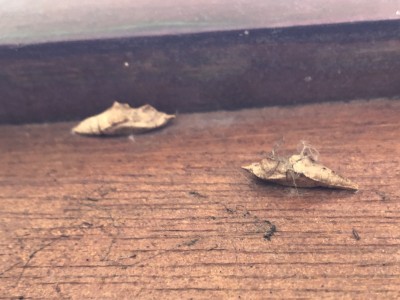
- “Small White pupae
After later inspection, these two were thought, might have been parasitised, before butterfly emergence.
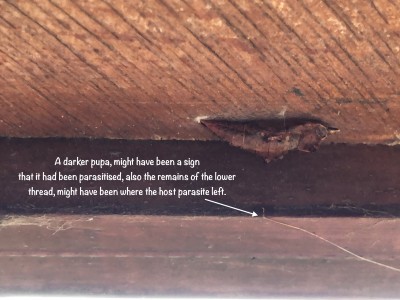
- April 13th 2020
Kind Regards
Re: PhilBWright
Posted: Mon Apr 20, 2020 4:09 pm
by PhilBJohnson
The Green-veined white species did not need (or was not known by me), to complete it's life cycle using vegetable crops in the United Kingdom.
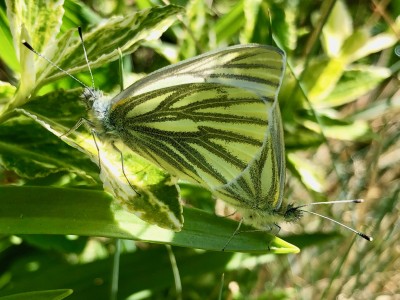
- 20th April 2020, Lincolnshire 14:01pm. Green-veined whites, paired. The male was top left (wings outside).
Re: PhilBWright
Posted: Tue Apr 21, 2020 5:59 pm
by David M
Lovely colours, Phil. This is a flighty species so a mating pair is the best opportunity you can expect.
Re: PhilBWright
Posted: Mon Apr 27, 2020 7:17 am
by PhilBJohnson
April 26th 2020, Lincolnshire
Brimstone butterfly ovipositing (egg laying) on Alder Buckthorn, harassed by male Small White butterfly.
The native Brimstone species in the United Kingdom needed Buckthorn or Alder Buckthorn, to sustain it's life cycles in the wild, or wild garden.
A Small White male butterfly harassed a female Brimstone butterfly.
Here was a video, made from clips taken in 720p definition, 240 frames/second, iPhone 6Plus:
https://youtu.be/CrmmmgK0lN8 (updated April 30th 2020)
Kind Regards
Re: PhilBWright
Posted: Tue Apr 28, 2020 10:53 am
by David M
Some lovely slow motion footage there, Phil. The Brimstone is so keen to lay she gets on with it whilst that male Small White is literally crawling up her wings!
Re: PhilBWright
Posted: Tue Apr 28, 2020 2:26 pm
by PhilBJohnson
Thanks David,
What became more obvious to me was that it might have been an evolutionary advantage for the female Brimstone to keep her wings tight shut (not always seen with male Brimstone courtship). She appeared to ignore, bending her abdomen away to deposit an egg. Another female butterfly's rejection (like you had seen), was to wave the abdomen in the air, like she had a repellant smell there.
Kind Regards
Re: PhilBWright
Posted: Tue Apr 28, 2020 9:16 pm
by David M
PhilBJohnson wrote: ↑Tue Apr 28, 2020 2:26 pmWhat became more obvious to me was that it might have been an evolutionary advantage for the female Brimstone to keep her wings tight shut (not always seen with male Brimstone courtship). She appeared to ignore, bending her abdomen away to deposit an egg. Another female butterflies rejection (like you know), was to wave the abdomen in the air, like she had a bad smell there.
Good point, Phil. A female can hardly oviposit whilst she's pointing her abdomen in the air at a marauding male.
I was fascinated to see how determined the Brimstone was to simply get on with it despite the harassment. I wonder if she'd have behaved similarly had it been a male of her own species? I have occasionally seen female Brimstones curve their abdomens upwards wings open when assailed by males, but the one in your video was decidedly steadfast in her intent to carry on with her business.
Re: PhilBWright
Posted: Thu Apr 30, 2020 6:12 pm
by PhilBJohnson
Thank you, David,
My video Brimstone video was updated (and link changed) to hopefully aid someone else's understanding of the larval food plants.
Kind regards
Re: PhilBWright
Posted: Fri May 01, 2020 7:34 am
by PhilBJohnson
During these C19 different times, I was fortunate to have a garden and be Employed as a Gardener.
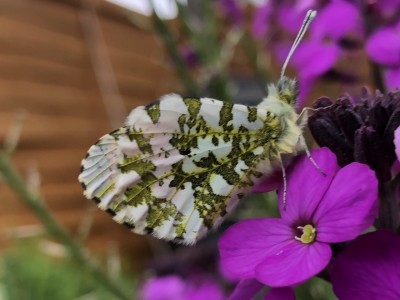
- Yesterday 15:03pm, ready for overnight roosting on perennial wall flower.
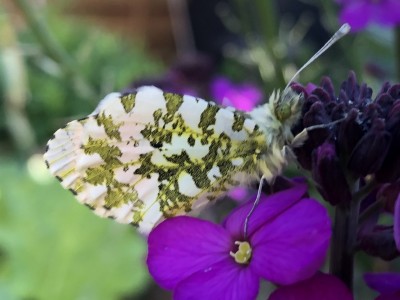
- 8:24am this morning, not the most camouflaged, nectar rich roosting position!
Re: PhilBWright
Posted: Thu May 07, 2020 5:37 am
by PhilBJohnson
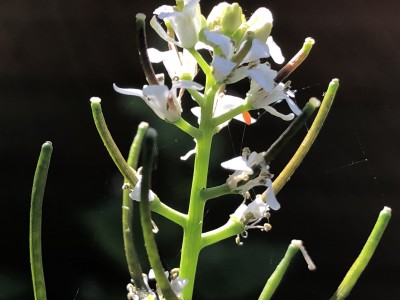
- May 6th 2020 iPhone picture of Orange Tip egg laid on Garlic Mustard, a private garden, Lincolnshire.
Re: PhilBWright
Posted: Thu May 07, 2020 7:20 pm
by David M
Very nice, Phil. Will you be rearing any or are you going to leave them to their own devices?
Re: PhilBWright
Posted: Sat May 09, 2020 8:11 am
by PhilBJohnson
Repotted scabious plants for butterfly loving flowers.
A Marsh Fritillary, as a batch, egg laying female, chose a large leaf to deposit her eggs, for evolutionary, selective reasons. The largest Devil’s-bit scabious (DBS) plant, was thought to be larger than the largest Field Scabious (FS) plant, so DBS was a slightly better leaf choice for a Marsh Fritillary web (nest of caterpillars).
DBS, apparently had the potential to grow larger than FS, liking a damp soil, where water was often showered with a watering can sprinkler, making it a looked after garden plant during a dry weather period. Water banks, water tanks or more water butts helped someone with their cost efficient habitat creation.
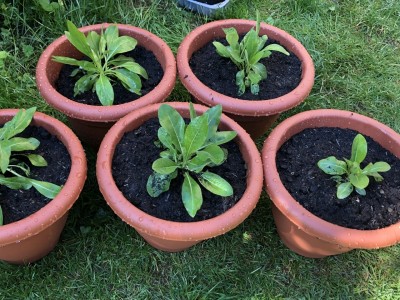
- Reported DBS May9th 2020, bought as “plug plants” from naturescape.co.uk in Autumn 2019
Re: PhilBWright
Posted: Fri May 15, 2020 7:11 am
by PhilBJohnson
It was thought it was a good idea to seed Garlic mustard (Garlic M) in two consecutive years as it was a biennial (taking two years to complete it's Life Cycle, like possibly an Arran Brown, before climate change in Scotland)

Seeding Garlic M in two consecutive years, for enclosed or isolated populations of Orange Tip butterfly (OT), was a caring, gardener's idea.
Seeding just once, was an appropriate action, for someone wanting an annual OT butterfly, emerging from a pupa, to travel further in flight to find a Garlic M flower.
In the second year after seeding, Garlic mustard "Bolted" (grew a tall flower spike for the Orange Tip butterfly).
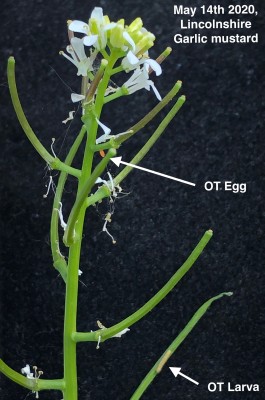
- Biennial Garlic mustard.
What Is a Biennial?
"In between annuals and perennials is another plant category known as biennials, which can be regarded as short-lived perennials that usually take two growing seasons to complete their life cycle. For the classic biennial, in its first growing season, the plant produces only foliage. In its second year, it will flower and set seed, often early in the season." Reference the spruce.com May 15th 2020
Garlic Mustard (With a large tap root established), was thought to have survived a Green-veined white larval feed and an English winter, into a second or third year.
Kind regards
Re: PhilBWright
Posted: Wed May 20, 2020 7:52 am
by PhilBJohnson
May 19th 2020 A less common sighting in Springtime.
Many "Large Brassica White butterflies" recorded in a previous early Spring were male.
I thought these were Spring brooded, 3rd instar,
Large Brassica White caterpillars on Garlic Mustard (Alliaria petiolata in the mustard family (
Brassicaceae).
Honestly, it was thought that Spring cabbages often did not have big enough leaves, to attract a female Large Brassica White. In more recent decades or centuries, cabbages had been grown in winter in warmer environments and some varieties have been hybridised to grow more (including seed germination) in colder temperatures.
Does anyone have significantly different larval colours for Spring larval broods, when “Cabbage White larva” were normally book displayed in Summer Brood?
These looked to me more blue (from a distance) and less yellow than those I saw last August:
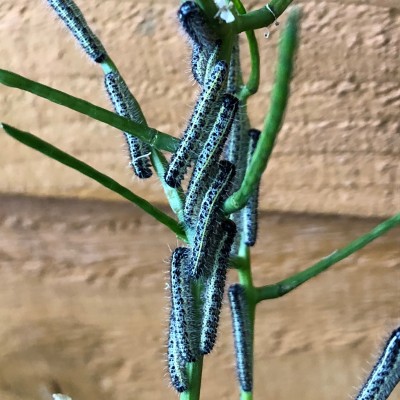
- May 19th 2020. 20:11pm Spring brooded Large White Garden caterpillars.
May 20th
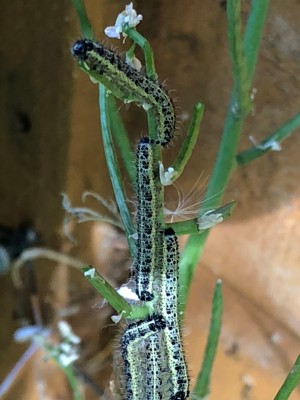
- 10:28am fed mainly on seedpods with little leaf damage noted.
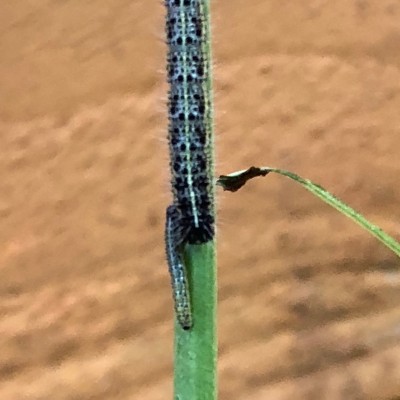
- Picture showing that there had been two broods on the same plant.
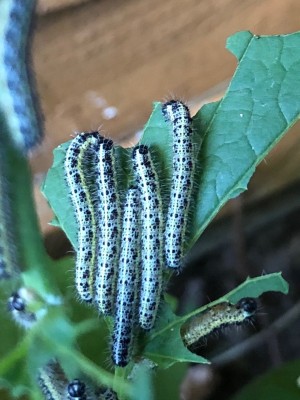
- 19:56pm Plant showed signs of significant leaf damage.
The Garlic mustard plant chosen by at least one female "Large brassica White" butterfly was not within a large group of garlic mustard plants, so it was thought, at some point soon, some of these caterpillars will need to go for a walk across the ground, looking for more food plants.
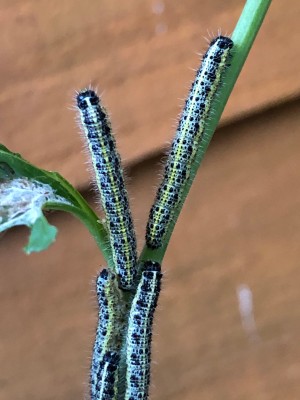
- May 20th 2020, Lincolnshire 19:59pm
Kind regards
Re: PhilBWright
Posted: Thu May 21, 2020 6:51 pm
by David M
Thanks for posting that, Phil. I didn't know Large White used garlic mustard as an LHP.
Re: PhilBWright
Posted: Fri May 22, 2020 5:38 am
by PhilBJohnson
Thanks David,
One thought was that native Garlic M, might be our most original native plant, most often used (not very often).
Cabbages had been selectively grown & hybridised for years, to produce bigger leaves in successive generations.
There were Wild Cabbages.
The female "Large Brassica White" might only feel secure (or behave in an evolved manner) under a large leaf to lay her batch of eggs
(like, for example, in a well watered garden , during a dry Spring).


More recently, growers and hybridisers chose Nasturtium plants for mass retail, that had smaller leaves, but flowered more profusely.
Someone wanted to be “in” growing Nasturtiums on their Council allotment, for using the flowers in a salad.
In ones own garden, I could suggest growing lots of different varieties. Chose the one that produces the biggest leaves and save all the seeds from that one, for next year.
It was thought that "Butterfly species purists" might end up seeking out, original native plants for their gardens, rather than those so called "bee friendly" flowers that were actually more sterile!
Kind Regards
Re: PhilBWright
Posted: Fri May 29, 2020 7:21 am
by PhilBJohnson
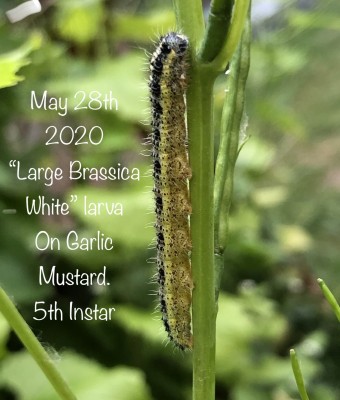
- Pieris brassicas (Large Brassica White) appearing to go through it’s Life Cycle very fast nearing the end of May 2020 (First Annual Brood).
Nasturtium Brood
Re: PhilBWright
Posted: Fri May 29, 2020 6:46 pm
by David M
Wow! Just goes to show how much they change appearance as they grow, Phil.
I presume there may be quite a few pupae on your plot very soon?